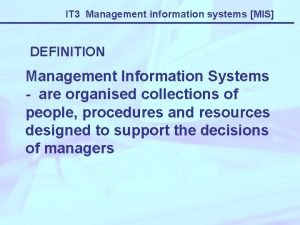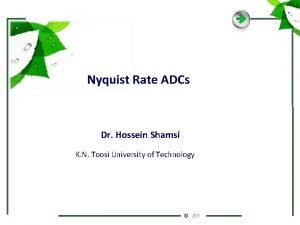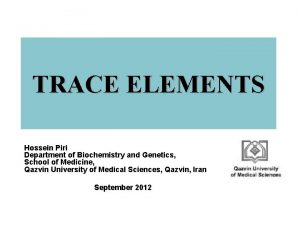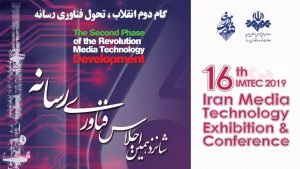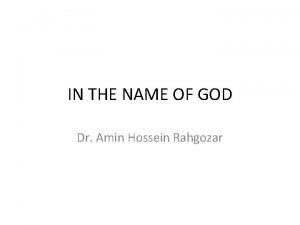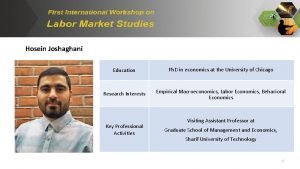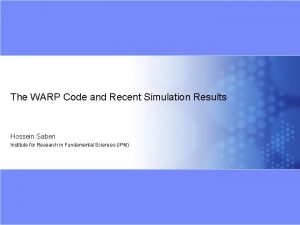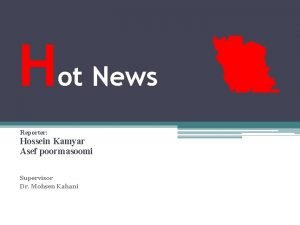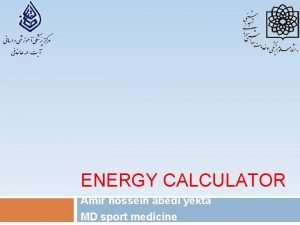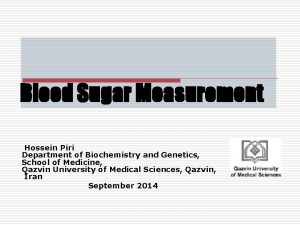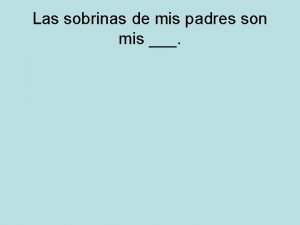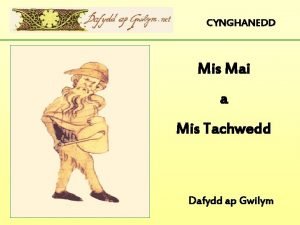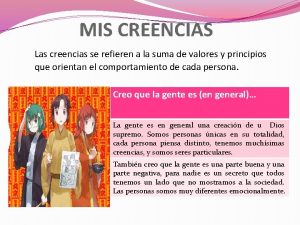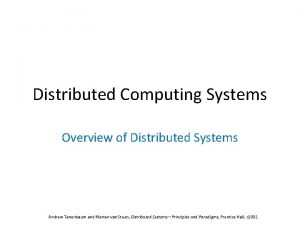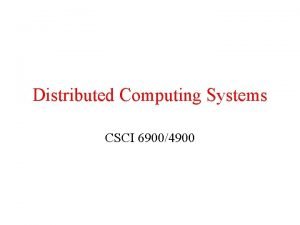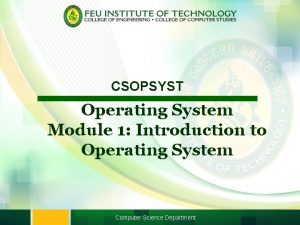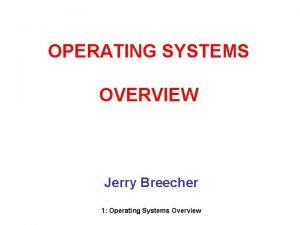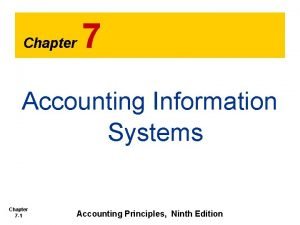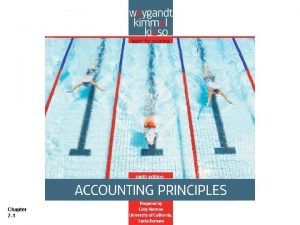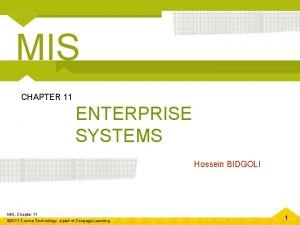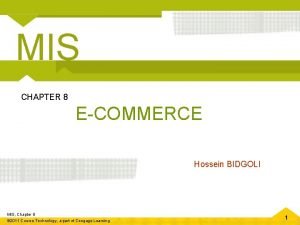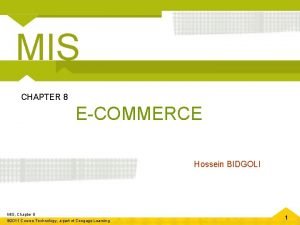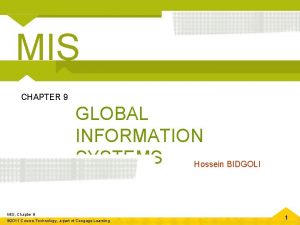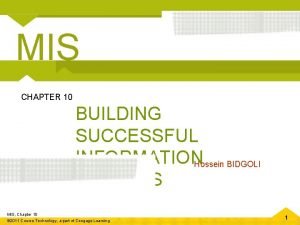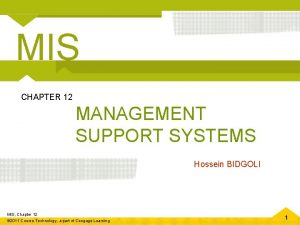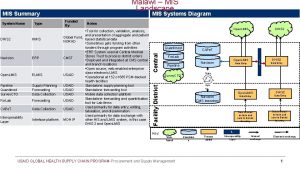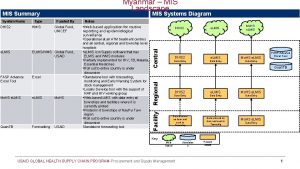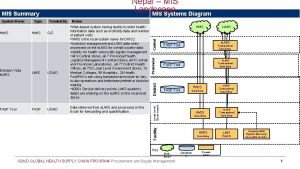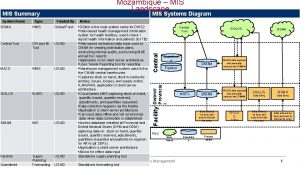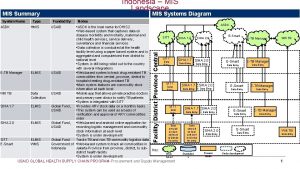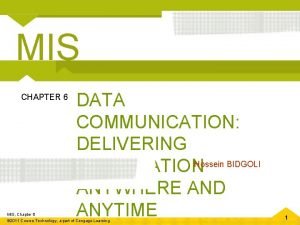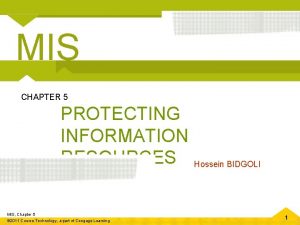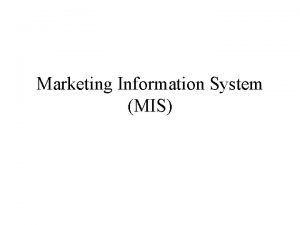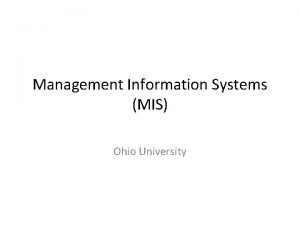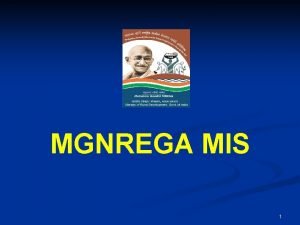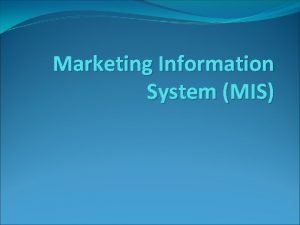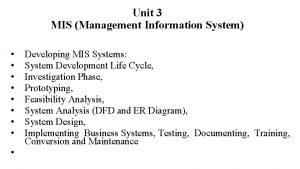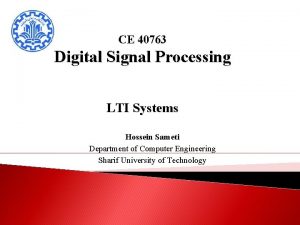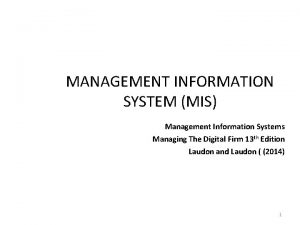MIS CHAPTER 1 INFORMATION SYSTEMS AN OVERVIEW Hossein




























- Slides: 28

MIS CHAPTER 1 INFORMATION SYSTEMS: AN OVERVIEW Hossein BIDGOLI MIS, Chapter 1 © 2011 Course Technology, a part of Cengage Learning 1

Chapter 1 Information Systems: An Overview learning outcomes LO 1 Discuss common applications of computers and information systems. LO 2 Explain the differences between computer literacy and information literacy. LO 3 Define transaction processing systems and management information systems. LO 4 Describe the four major components of an information system. LO 5 Discuss the differences between data and information. MIS, Chapter 1 © 2011 Course Technology, a part of Cengage Learning 2

Chapter 1 Information Systems: An Overview l e a r n i n g o u t c o m e s (cont’d. ) LO 6 Explain the importance and applications of information systems in functional areas of a business. LO 7 Discuss how information technologies are used to gain a competitive advantage. LO 8 Explain the Five Forces Model and strategies for gaining a competitive advantage. LO 9 Summarize the future outlook of information systems. MIS, Chapter 1 © 2011 Course Technology, a part of Cengage Learning 3

Chapter 1 Information Systems: An Overview Management Information Systems • Management information system (MIS) – Organized integration of hardware and software technologies, data, processes, and human elements – Designed to produce timely, integrated, relevant, accurate, and useful information • For decision-making purposes • Include: – Hardware components – MIS software – Processes MIS, Chapter 1 © 2011 Course Technology, a part of Cengage Learning 4

Chapter 1 Information Systems: An Overview Management Information Systems (cont’d. ) • Designing an MIS – Define objectives – Collect and analyze data – Provide information in useful format • Used in both the private and public sect • Many organizations use information systems to gain a competitive advantage MIS, Chapter 1 © 2011 Course Technology, a part of Cengage Learning 5

Chapter 1 Information Systems: An Overview Major Components of an Information System • • Database Process Information MIS, Chapter 1 © 2011 Course Technology, a part of Cengage Learning 6

Chapter 1 Information Systems: An Overview Data • Data – Input to the system • Sources of data – External – Internal • Time orientation • Can be collected in different forms – Aggregated – Disaggregated MIS, Chapter 1 © 2011 Course Technology, a part of Cengage Learning 7

Chapter 1 Information Systems: An Overview Database • Database – Heart of an information system – Collection of all relevant data organized in a series of integrated files • Essential for the success of any information system • Managed with database management system (DBMS): e. g. , Oracle • Reduces personnel time needed to gather, process, and interpret data manually MIS, Chapter 1 © 2011 Course Technology, a part of Cengage Learning 8

Chapter 1 Information Systems: An Overview Process • Process – Generates the most useful type of information for decision making • Generally includes transaction-processing reports and models for decision analysis • Includes a wide range of models to support all levels of decision making MIS, Chapter 1 © 2011 Course Technology, a part of Cengage Learning 9

Chapter 1 Information Systems: An Overview Information • Information – Output of an information system – Facts that have been analyzed by the process component • Quality of information – – Timeliness Integration with other data and information Consistency and accuracy Relevance MIS, Chapter 1 © 2011 Course Technology, a part of Cengage Learning 10

Chapter 1 Information Systems: An Overview Information (cont’d. ) • User interface – Must be flexible and easy to use – Graphical user interfaces (GUIs) • Ultimate goal of an information system – Generate business intelligence (BI) MIS, Chapter 1 © 2011 Course Technology, a part of Cengage Learning 11

Chapter 1 Information Systems: An Overview Using Information Systems and Information Technologies • Information technologies – Achieve goals of information systems • Examples – – Internet Databases POS Systems RFID tags MIS, Chapter 1 © 2011 Course Technology, a part of Cengage Learning 12

Chapter 1 Information Systems: An Overview The Importance of Information Systems • Information – Second most important resource in any organization • Four Ms of resources: – – Manpower Machinery Materials Money MIS, Chapter 1 © 2011 Course Technology, a part of Cengage Learning 13

Chapter 1 Information Systems: An Overview The Importance of Information Systems (cont’d. ) • Personnel information system (PIS) or human resource information system (HRIS) – Designed to provide information that helps decision makers in personnel carry out their tasks more effectively – Use Web technologies • Main difference between an intranet and the Internet – Intranets are private and the Internet is public MIS, Chapter 1 © 2011 Course Technology, a part of Cengage Learning 14

Chapter 1 Information Systems: An Overview The Importance of Information Systems (cont’d. ) • Logistics information system (LIS) – Designed to reduce the cost of transporting materials – Maintains safe and reliable delivery • Manufacturing information system (MFIS) – Manages manufacturing resources – Companies can reduce manufacturing costs, increase product quality, and improve inventory decisions MIS, Chapter 1 © 2011 Course Technology, a part of Cengage Learning 15

Chapter 1 Information Systems: An Overview The Importance of Information Systems (cont’d. ) • Financial information system (FIS) – Provides information to financial executives in a timely manner • Marketing information system (MKIS) – Improve marketing decisions – Provide timely, accurate, and integrated information about the marketing mix MIS, Chapter 1 © 2011 Course Technology, a part of Cengage Learning 16

Chapter 1 Information Systems: An Overview Using Information Technologies for a Competitive Advantage • Michael Porter – Professor at Harvard Business School – Identified three strategies for competing in the marketplace successfully • Overall cost leadership • Differentiation • Focus MIS, Chapter 1 © 2011 Course Technology, a part of Cengage Learning 17

Chapter 1 Information Systems: An Overview Using Information Technologies for a Competitive Advantage (cont’d. ) • Information systems – Help organizations reduce the cost of products and services – Assist with differentiation and focus strategies – Can help bottom-line and top-line strategies • Enterprise systems – – Supply chain management (SCM) Customer relationship management (CRM) Enterprise resource planning (ERP) Collaboration software MIS, Chapter 1 © 2011 Course Technology, a part of Cengage Learning 18

Chapter 1 Information Systems: An Overview Using Information Technologies for a Competitive Advantage (cont'd. ) • Differentiation strategies – Make products and services different from competitors – Examples: Apple, Amazon. com MIS, Chapter 1 © 2011 Course Technology, a part of Cengage Learning 19

Chapter 1 Information Systems: An Overview Using Information Technologies for a Competitive Advantage (cont'd. ) • Focus strategies – Concentrate on a specific market segment – Attempt to achieve a cost or differentiation advantage – Examples: Apple, Abercrombie & Fitch, Nordstrom MIS, Chapter 1 © 2011 Course Technology, a part of Cengage Learning 20

Chapter 1 Information Systems: An Overview Porter’s Five Forces Model: Understanding the Business Environment • Five Forces Model – Michael Porter – For analyzing an organization, its position in the marketplace, and how information systems could be used to make it more competitive – Buyer power – Supplier power – Threat of substitute products or services – Threat of new entrants – Rivalry among existing competitors MIS, Chapter 1 © 2011 Course Technology, a part of Cengage Learning 21

Exhibit 1. 4 MIS, Chapter 1 © 2011 Course Technology, a part of Cengage Learning The Five Forces Model 22

Chapter 1 Information Systems: An Overview Porter’s Five Forces Model: Understanding the Business Environment • Buyer power (cont'd. ) – High when customers have many choices – Low when they have few choices – Limit buyers’ choices by offering services that make it difficult for customers to switch • Supplier power – High when customers have fewer options – Low when customers have more options – Use information systems to make their products and services cheaper MIS, Chapter 1 © 2011 Course Technology, a part of Cengage Learning 23

Chapter 1 Information Systems: An Overview Porter’s Five Forces Model: Understanding the Business Environment (cont'd. ) • Threat of substitute products or services – High when many alternatives for an organization’s products or services available – Add services to make organization more distinct – Add fees to discourage customers from switching • Threat of new entrants – Low when duplicating a company’s product or service is difficult – Use focus strategies to ensure that this threat remains low MIS, Chapter 1 © 2011 Course Technology, a part of Cengage Learning 24

Chapter 1 Information Systems: An Overview Porter’s Five Forces Model: Understanding the Business Environment • Rivalry among(cont'd. ) existing competitors – High when many competitors occupy the same marketplace position – Low when there are few competitors MIS, Chapter 1 © 2011 Course Technology, a part of Cengage Learning 25

Chapter 1 Information Systems: An Overview Future Outlooks • Hardware and software costs continue to decline – Processing information less expensive in the future • Artificial intelligence and related technologies will continue to improve and expand • Computer literacy will improve • Networking technology will improve • Personal computers will continue to improve in power and quality MIS, Chapter 1 © 2011 Course Technology, a part of Cengage Learning 26

Chapter 1 Information Systems: An Overview Future Outlooks (cont'd. ) • Internet growth and acceptance will continue • Computer criminals will become more sophisticated – Protecting personal identity information will become more difficult MIS, Chapter 1 © 2011 Course Technology, a part of Cengage Learning 27

Chapter 1 Information Systems: An Overview Summary • Examples of uses for computers and information systems • Difference between computer literacy and information literacy • Management information system (MIS) – Data, database, process, and information • Porter – Three competitive strategies – Five Forces Model MIS, Chapter 1 © 2011 Course Technology, a part of Cengage Learning 28
 Management information systems (mis)
Management information systems (mis) What is management information systems
What is management information systems Cw.sharif
Cw.sharif Hossein shamsi
Hossein shamsi Hossein sameti
Hossein sameti Hossein zeinali
Hossein zeinali Hossein piri
Hossein piri Dr. hossein farahini
Dr. hossein farahini Amin hossein rahimi
Amin hossein rahimi Hosein joshaghani
Hosein joshaghani Hossein piri
Hossein piri Language eng
Language eng Amir hossein abedi
Amir hossein abedi Hossein piri
Hossein piri Proyecto de vida vision
Proyecto de vida vision La hija de la hija del tío de mi padre es mi
La hija de la hija del tío de mi padre es mi Mis mai a mis tachwedd
Mis mai a mis tachwedd Mis mai a mis tachwedd
Mis mai a mis tachwedd Mis actos son un reflejo de mis creencias
Mis actos son un reflejo de mis creencias Distributed systems overview
Distributed systems overview Sap project systems overview
Sap project systems overview Distributed systems overview
Distributed systems overview Overview of operating systems
Overview of operating systems Operating system overview
Operating system overview Management information system chapter 1
Management information system chapter 1 Chapter 8 securing information systems
Chapter 8 securing information systems Chapter 8 securing information systems
Chapter 8 securing information systems Chapter 7 accounting information systems
Chapter 7 accounting information systems Chapter 7 accounting information systems
Chapter 7 accounting information systems

